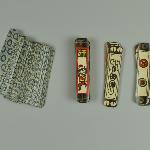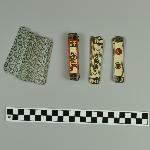Playing Card Deck
29-238-15
From: China | Anhui
Curatorial Section: Asian
| Object Number | 29-238-15 |
| Current Location | Collections Storage |
| Culture | Chinese |
| Provenience | China | Anhui |
| Period | 19th Century |
| Date Made | 1889 - 1893 |
| Section | Asian |
| Materials | Paper | Ink |
| Technique | Printed |
| Iconography | Money Suited | White Flower | Old Thousand | Wang Ying | Water Margin |
| Inscription Language | Chinese Language |
| Description | Incomplete deck of 154 playing cards (1 missing) called "Stick cards" or Gun Pai 棍牌. This type of deck contains money cards with three suits: 1-9 of cash coins, 1-9 of strings (of cash) and 1-9 of myriads. There are also three extra cards: the Old Thousand, White Flower, and Wang Ying. Additionally there are five extra cards functioning as wild cards or jokers. The five joker cards are the Five Blessings: 福 (good fortune), 祿 (promotion), 壽 (long life), 財 (wealth), 喜 (joy) and show the respective gods under their names. In the suits of cash and strings the value is depicted by the actual number of coins or strings of coins. In the suit of myriads the value is written out on the top and bottom of the cards. The myriads suit also contains characters from the Water Margin story. They appear on the 1, 2, 5, 7, and 9. The 3 of myriads has the text 楊裕記 Yang Yuji "mark of Yang" on it. The Old Thousand court card which has 万千 Qian Wan at the top has a portrait of a person without a name. The zhihua 白花 (white flower) court card has a picture of a deer and the plant of long life (polyporus lusidus) onit. On the Wang Ying card is a portrait of Wang Ying and his name 王英 in an oblique shield above him. Of the 5 sets of 30 cards there are two sets in which the 1's, 2's, 5's, 8's, 9's, White Flower, Old Thousand, and Wang Ying are colored. The jokers are all colored. The cards have double indices showing both the suit and the value. For example all the 2 cards have a circle centered at the top and bottom of the card, the suit is indicated by a dot in the center for cash, a blank circle for myriads, and a line down the middle of the cricle for strings. The cards are rectangular with rounded corners and the backs are white and blue with a hexagonal motif. Some cards are colored red, silver, yellow, and pale green. There is a slighty shiny coating on the cards. From Culin publication: "From Anhui Province. Five packets of thirty each, and five jokers - the Five Blessings. In the following cases two of the five are colored, three are plain: In each suit. 1,2,5,8,9; Old Thousand, Wong Ying, White Flower; jokers, Posterity and Wealth (total different cards, 10). Index marks for pips, suits, coat cards, and jokers. When the cards are colored, these index marks are for myriads and cakes in gold; for strings and jokers, in gold and red; when the cards are plain, the index marks are in white, except for nine of cakes (in red and white), and the coat cards. Diapered backs. Total, 155. Fig. 128." |
| Length | 8.1 cm |
| Width | 1.7 cm |
| Credit Line | Purchased from William Henry Wilkinson, 1903 |
| Other Number | Wilkinson 15 - Collector Number | 29-191-241.2 - Old Museum Number |
Report problems and issues to digitalmedia@pennmuseum.org.




